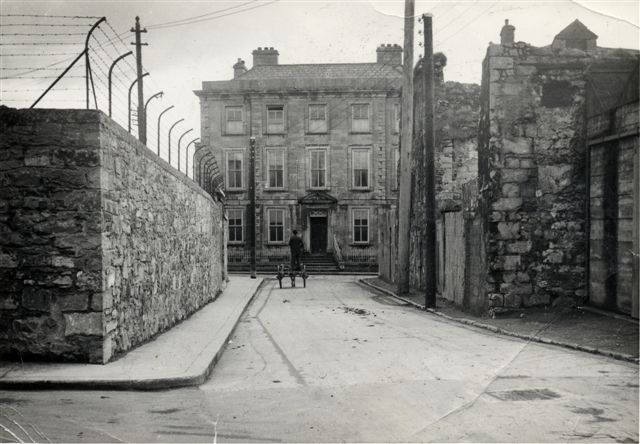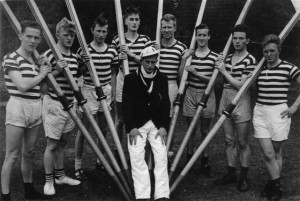Old Galway
U. C. G. Rugby Club (11 04 13)

The rugby club in UCG was founded in1874, which makes it the oldest such club in Connacht. They played in the Bateman Cup competition many times and won their first Connacht Senior Cup in 1897. They have held this trophy aloft 34 times in all, more than any other club in the west, and they have won the senior league 16 times. They won the Dudley Cup for the first time in 1905. Many of their players have played for Irish Universities International teams, and ten have been capped for Ireland, several while playing for UCG. One of those, Ciaran Fitzgerald, captained the British and Irish Lions. The UCG colours are maroon and white.
Scoil Fhursa, 80 Years (04 04 13)

Scoil Fhursa opened on the 24th of April 1933, 80 years ago this month. It was named after the ‘laborious preacher and famous visionary’, St. Fursey who was born on Inchiquin on the Corrib towards the end of the 6th century. He performed many miracles both here and on the continent. The school building has an interesting and varied history. It was built by a group known as “The Irish Church Missions” who were set up in the UK with a view to converting Roman Catholics ‘from the errors of Popery’.They were told the west of Ireland would be a fruitful field for proselytising and so established a school in two houses in Merchant’s Road
MAYORALTY HOUSE AND LOWER CROSS STREET (28 03 13)

This photograph of Cross Street was taken in 1946. Early maps of the city show an open air altar at the end of the street. It was built by the Dominicans and used for various processions and Corpus Christi. The building facing us is Mayoralty House which was originally built in 1793 for a member of the Daly family. This family exclusively held the office of mayor from 1776 to 1816. It was probably built by James Daly who was mayor in 1804, 1810, 1814, 1818 & 1819. The Dalys owned the house until the late 1840’s. In Griffith’s Valuations in 1855, there is no mention of Mayoralty House, but a house fitting its description belongs to the Town Commissioners. These had replaced the Mayor and Corporation about 1935. It was later used as a police barracks.
THE MAGDALEN ASYLUM, GALWAY (21 03 13)

The Magdalen Asylum in Galway was founded in 1824 by a private person, Ms. Lynch, and was managed by a society known as The Association of Ladies of the Saint Magdalen Society. At the request of the founder, the Sisters of Mercy became responsible for the operation of the institution following her death in 1845. The laundry and living quarters were separate from the convent/mother house in Galway. The living quarters included three dormitories, a kitchen, dining room, infirmary, recreation room and a chapel. There was also a farm across the road.In the late 1800’s, there were at least 41 Magdalen Institutions in Ireland and they were known as Asylums, Refuges or Penitentiaries.
THE HEAD OF THE RIVER (14 03 13)

Rowing is a sport of endurance, strength and finesse, a sport naturally suited to Galway where the river connects Lough Corrib with the sea. The earliest reference we have to competitive rowing on the Galway River is 1839. The first rowing club established here was the Corrib Rowing and Yachting Club in 1864 (149 years ago!) and as other clubs formed, ‘rowing matches’ became more competitive. In 1868, Commercial Rowing Club was formed and the inter-club rivalry generated a lot of interest in the sport.Later came the Royal Galway Yacht Club; St. Patrick’s Rowing Club which was also known as the Temperance Club; Celtic Rowing Club;
A Procession on O'Brien's Bridge (07 03 13)

Our photograph today is of a group from the Sodality in the Jes being led by Bobby Molloy with the IHS flag. They are crossing O’Brien’s Bridge as part of the annual Procession of the Most Blessed Sacrament. Willy Forken is in front of the right hand row, and among the others are Johnny Holland and Johnny Whelan.
STUDENT REVOLUTIONARIES (28-02-13)

Seamus Murphy was the officer commanding the Galway Brigade of the IRA from 1917 to 1920. He was very conservative and vetoed a lot of proposed operations. He eventually moved back to Dublin where he was heard complaining that he could not get any Galway men to fight. At one stage he made tear gas for the University College Galway Company of the IRA and he nearly blinded himself in the process. This company took part in the ambush on the Lough George barracks in May 1920.“Paddy Mullins was in charge. Nicko Ryan was the local commandant. The British captured one of our scouts who was the son of a head constable of the RIC.
The Joyces of Mervue (21-02-13)

The first recorded use of the name Joyce was Joy in the 13th century State papers. Sometime the name was rendered as Joy, Joyces, Jorz, Jorse or the standard spelling --- Joyce. The Joyces of Mervue were a distinguished branch of the family. Marcus Joyce, a rich merchant who bought land in County Mayo in the late 16th century, was probably the founder of this branch. About a century later, the Joyces emerged as a leading merchant family in Galway. Hardiman states that Joyce’s house was at the corner of Abbeygate Street and Market Street and that this family was head of the name’. They were eminent wine merchants.
.png)